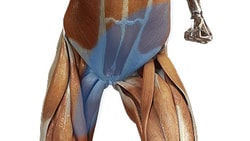4 Common Problems with Wheelchair Pelvic Positioning--And Their Solutions
August 22, 2018
6 min. read

The pelvis is often referred to as the cornerstone of positioning because of the crucial role it plays in the positioning of the trunk and the stability of the extremities and head. Your clients who use wheelchairs may be affected by these four common seating challenges, so knowing how to identify themand solve themwill greatly improve your clients comfort and quality of life.
Problem #1: Posterior Pelvic Tilt
What Is It?
In a posterior pelvic tilt, the top of the pelvis is tipped rearward. This rotational movement of the pelvis results in a flexed or kyphotic trunk.

Correcting a posterior pelvic tilt with a neutral alignment of the pelvis will:
Support the anatomical curvature of the spine
Promote weight bearing on the ischial tuberosities (ITs) to reduce pressure risk
Provide optimal alignment for anatomical function
Increase proximal stability for function
What Causes It?
Low tone in the trunk
Tight hamstrings
Tight hip flexors
Overlong seat depth
The client sliding forward or actively extending on the seat
How Should I Solve It?
Adequate posterior support to the pelvis will prevent the rearward movement that results in posterior pelvic tilt. One option is a biangular back, which keeps the pelvis in an upright, neutral tilt while also allowing the trunk to extend beyond the pelvis.
If the problem is tight hamstrings, you can alleviate the pull on the muscle by either opening the seat-to-back angle or decreasing the angle of the upper leg to the lower leg.
When limited hip flexion is the issue, flexing the hip pushes the pelvis into a posterior tilt. This can be solved by opening the seat-to-back angle.
If your client is sliding and extending, you can employ two solutions in tandem. First, an anti-thrust cushion creates a curb in front of the ITs to prevent the client from slipping forward. Next, placing a pelvic positioning belt at a 60-degree angle to the client (rather than the more typical 45-degree angle) will also prevent this forward movement.
Problem #2: Anterior Pelvic Tilt
What Is It?
An anterior pelvic tilt occurs when the top of the pelvis moves forward, hyperextending the lumbar area and causing the spine to assume a more lordotic position.

By addressing the anterior pelvic tilt, you can:
Reduce the accompanying lordosis
Achieve neutral alignment of the pelvis for weight bearing on the ITs
Optimize biomechanical function
Increase proximal stability for function
What Causes It?
Postural collapse secondary to muscle paralysis, weakness, or low tone
High tone
How Should I Solve It?
Placing the pelvic positioning belt directly over the anterior superior iliac spine (ASIS) pulls the pelvis back into a neutral position. You can achieve this by mounting a four-point pelvic positioning belt at 30 degrees. A secondary belt positioned between 60 and 90 degrees maintains the primary belts position, preventing it from moving above the ASIS onto soft tissue.
Another treatment option is to use an abdominal panel (sometimes called a belly binder or corset) to reduce lordosis and, as a result, anterior pelvic tilt. The abdominal panel should contact the top of the pelvis and lower ribs to prevent undue pressure to the soft tissue.
Problem #3: Pelvic Rotation
What Is It?
Pelvic rotation occurs when one ASIS is more forward than the other.

By resolving this issue, you will:
Support the anatomical curvatures of the spine
Promote weight bearing on the ITs
Achieve alignment for biomechanical function
Provide proximal stability for function
Prevent trunk rotation
Increase pressure distribution over the posterior trunk
What Causes It?
Range-of-motion limitations in the hips, including abduction, adduction, and flexion
A leg-length discrepancy that has not been addressed in the seating system
Hip dislocation, rather than an actual difference in femur length
Discomfort that causes the client to rotate the pelvis in an effort to alleviate the pain
Tone and reflex activity such as asymmetrical tonic neck reflex (ATNR) that pulls the pelvis into rotation
How Should I Solve It?
If the clients range of motion is limited, placing the lower extremities directly in front of the client may result in pulling the pelvis into rotation. Instead, place the legs in an asymmetrical posture, often known as a windswept posture, to allow the pelvis to remain neutral.
You can accommodate a leg-length discrepancy with an asymmetrical seat depth. When pain is the culprit, work closely with your clients medical team to identify the source of the pain and solve it, if possible. If increased tone or reflexes are contributing to pelvic rotation, increasing flexion and abduction may break up the tone.
In this case, the angle of the pelvic positioning belt is not as important as the direction in which it is tightened or pulled. For instance, if your client is rotating forward on the left-hand side, the pelvic belt should pull down on the left, tightening the belt and de-rotating the pelvis. An anti-thrust seat can also be helpful since this blocks the motion of the IT that tends to move forward.
Problem #4: Pelvic Obliquity
What Is It?
Pelvic obliquity is when one side of the pelvis is higher than the other, resulting in a lateral curvature of the spine. One common consequence of pelvic obliquity is pressure ulcers located under an IT.

Correcting a flexible obliquity or accommodating a fixed obliquity provides the best alignment for biomechanical function so you can:
Level the head
Level the pelvis
Equalize pressure under the pelvis at the ITs
What Causes It?
Lateral sclerosis
ATNR
Hip surgeries
Discomfort, since the client may assume an obliquity in an attempt to shift their weight off of a painful hip
How Should I Solve It?
In a flexible obliquity, changing the angle of the pelvic belt to 90 degrees (over the belt) may be all that is required. However, if the client has a dislocated hip this will not be effective. And if rotation or a posterior pelvic tilt are also present, a four-point belt may be indicated.
The other primary intervention for obliquity is wedging. If the obliquity is flexible, a wedge is placed under the seat on the low side to level the pelvis. In a fixed obliquity, a wedge is placed under the seat on the high side to better distribute pressure between the ITs. A pressure map will help determine if the pressure is well-distributed.
After wedging a fixed obliquity, the client may be unable to laterally balance their head, depending on the amount of lateral scoliosis. In this case, a lateral tilt may be required to level the head over the pelvis.
Client comfort is key to their quality of life. By knowing how to identify these issues and their causes and quickly addressing them, you can help your clients sit comfortably while supporting their anatomy and reducing the risk of complications like pressure ulcers.





